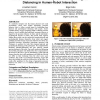Free Online Productivity Tools
i2Speak
i2Symbol
i2OCR
iTex2Img
iWeb2Print
iWeb2Shot
i2Type
iPdf2Split
iPdf2Merge
i2Bopomofo
i2Arabic
i2Style
i2Image
i2PDF
iLatex2Rtf
Sci2ools
HRI
2011
ACM
2011
ACM
Human-robot proxemics: physical and psychological distancing in human-robot interaction
To seamlessly integrate into the human physical and social environment, robots must display appropriate proxemic behavior—that is, follow societal norms in establishing their physical and psychological distancing with people. Socialscientific theories suggest competing models of human proxemic behavior, but all conclude that individuals’ proxemic behavior is shaped by the proxemic behavior of others and the individual’s psychological closeness to them. The present study explores whether these models can also explain how people physically and psychologically distance themselves from robots and suggest guidelines for future design of proxemic behaviors for robots. In a controlled laboratory experiment, participants interacted with Wakamaru to perform two tasks that examined physical and psychological distancing of the participants. We manipulated the likeability (likeable/dislikeable) and gaze behavior (mutual gaze/averted gaze) of the robot. Our results on physical distancing sho...
Gaze Behavior | HRI 2011 | Human Computer Interaction | Human Robot Interaction | Interaction Categories |
| Added | 28 Aug 2011 |
| Updated | 28 Aug 2011 |
| Type | Journal |
| Year | 2011 |
| Where | HRI |
| Authors | Jonathan Mumm, Bilge Mutlu |
Comments (0)

